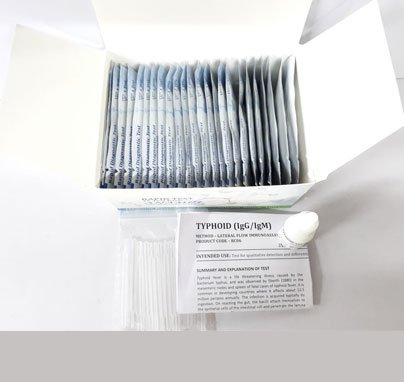SALMONELLA ANTIBODY (IgG/IgM) CARD
Intended Use:
Test for qualitative detection and differentiation of IgG/IgM antibodies of S. typhi and S. paratyphi.
Introduction:
Typhoid fever is a life threatening illness caused by the bacterium typhus, and was observed by Eberth (1880) in the mesenteric nodes and spleen of fatal cases of typhoid fever. It is common in developing countries where it affects about 12.5 million persons annually. The infection is acquired typically by ingestion. On reaching the gut, the bacilli attach themselves to the epithelial cells of the intestinal villi and penetrate the lamina and submucosa. They are then phagocytosed there by polymorphs and mesenteric lymph nodes, where they multiply and, via the thoracic duct, enter the blood stream. A transient bacteremia follows, during which the bacilli are seeded in the liver, gall bladder, spleen, bone marrow, lymph nodes, and kidneys, where further multiplication takes place. Towards the end of the incubation period, there occurs a massive bacteremia from these sites, heralding the onset of the clinical symptoms. The diagnosis of typhoid consists of isolation of the bacilli and the demonstration of antibodies. The isolation of the bacilli is very time consuming and antibody detection is not very specific. Other tests include the widal test that takes only 10-30 minutes and requires only a small amount of serum or plasma to perform.
Salmonella Antibody Card

Method Principal:
The S. typhi IgG/IgM Test Device (Serum/Plasma) is a qualitative test for the detection of IgG and IgM antibodies to S. typhi in human serum or plasma. The test provides a differential detection of anti-S. typhi-IgG and anti-S. typhi -IgM antibodies and can be used for the presumptive distinction between a current, latent and/or carrier S. typhi infection. Serum or plasma samples may be used with this test. First a specimen is dispensed into the sample well of the test device. If IgG or IgM antibodies to S. typhi are present in the specimen they will bind to the colloidal gold-antigen conjugate and travel up the membrane chromatographically. The antibody-Antigen-colloidal gold complex will then bind to the immobilized anti-Human IgG and/or anti-Human IgM coated on the membrane. This will cause pale to dark coloured lines to form at the IgG or IgM test region and can be seen in the results window. The intensity of the lines will vary depending upon the amount of antibody present in the sample. The appearance of a coloured line in a specific test region should be considered as positive for that particular antibody (IgG and/or IgM). To serve as a procedural control, a coloured line will always appear in the control line region indicating that proper volume of specimen has been added and proper membrane wicking has occurred.
| Pack Sizes | 25 Test. 50 Test |
| Kit components | Test Device. Assay Buffer. Instructions for Use |
| Test Procedure | Qualitative only |
| Sample Type | Serum or Plasma |
| Kit dimensions | 25 test – 75x150x110 mm. 50 test – 75x275x135 mm |
| Approx. weight of kit | 25 test – 150 gms. 50 test – 300 gms |
| Storage Temperature | Room Temperature |
| Shelf life | 24 months |
| Production Capacity | 50 mn tests per annum |
